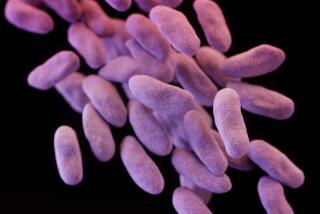Gut bacteria: Each species may need its own kind
- Share via
Last week, scientists reported on a 5-year study of all the bacteria that inhabit the human body – 100 trillion of them, weighing 2 to 6 pounds total (in a 200-pound person) – and of 10,000 different types, though not all of them will reside in any one particular person.
This week, an interesting article published in the journal Cell points to just how crucial the correct bacteria may be for developing a robust immune system.
Scientists know that mice reared in a germ-free environment don’t develop normally. Their guts look different and they don’t absorb food as well as germy mice.
Plus there are abnormalities in the immune cells and immune processes around the intestine. (The gut is a hive of immune-cell activity, which makes sense -- our bodies need protecting from all the stuff in the outside world that gets in there.)
The germ-free mice are more prone to infections. And they’re more prone to inflammatory problems. If you add back mouse microbes to their guts, a lot of these problems melt away.
So here was the question: For immune maturation, how much does it matter which precise microbes take up residence within us? Just how persnickety are we? A team of scientists decided to look into that.
They took germ-free mice and colonized them with two populations of bacteria:
--ones taken from guts of mice.
--ones taken from guts of 12 different people.
The findings:
First, though these two sets of mice had similar numbers of microbes growing inside them, the microbial populations that developed were very different at the species and strain level. The most striking differences were observed within a large grouping of bacteria called Firmicutes: Though there were Firmicutes aplenty in both types of mice -- 1,321 different types -- only 20 of the specific types were shared.
Second, there were similar immune system defects in germ-free mice and the mice with human bacteria in them -- such as fewer T cells of various types in the small intestine, improper activation and proliferation of immune cells, different gene activity in immune cells and lowered production of antimicrobial chemicals.
Third, mice with human-style microbes in them were more susceptible to gut infections with a disease-causing Salmonella strain than were normal mice. Perhaps that’s because of the immune deficiencies, the authors said. Or maybe the mouse-specific bacteria are better at competing with and controlling the Salmonella in the gut than the human microbes would be.
Or both?
The scientists did a variety of other experiments. Among these, they tried populating the intestines of germ-free mice with microbes obtained from the guts of rats. (Hey, they’re both rodents. They eat the same kind of chow, and food influences gut populations a lot.)
No dice. The rat bugs didn’t restore the gut immune functions the way that adding back mouse bugs did.
The authors’ conclusion: “That mammalian hosts have coevolved with a specific consortium of bacterial species that stimulates intestinal immune maturation.”
Finally, the authors say their study puts a new twist on the hygiene hypothesis -- the idea that underexposure to germs while growing up raises the risk for autoimmune disesases. The new twist is that you have to be exposed to microbes of the right type for your species.
“Heavy processing of food, frequent treatment with antibiotics and advances in hygiene in industrialized countries may have reduced the stability and transfer of host microbes promoting health,” they write.
Here’s an interesting video explaining the study featuring senior author Dennis Kasper of Harvard Medical School.
And if you look at the right side of the Web page featuring the research paper, you can listen to an interview with Kasper. Look for the yellow button called “PaperClip.”




